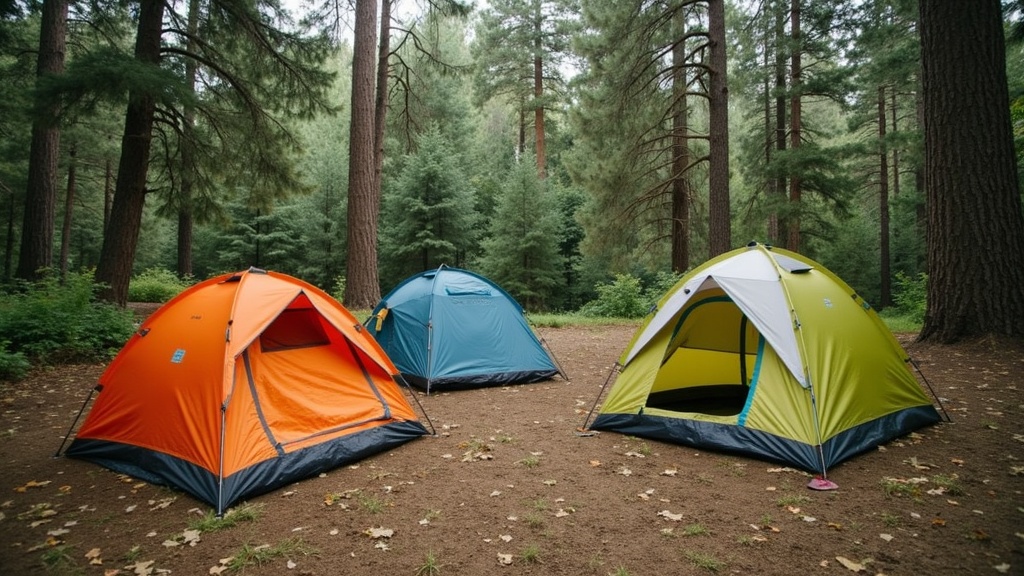
Tent camping offers a flexible way to enjoy the outdoors. Whether you’re planning a weekend at a national park or a long road trip, the right tent plays a big part in how enjoyable your experience is. I’ve spent years testing different tents, ranging from high-end models packed with features to simple affordable options that just do the job. So, in this article, I’ll share what I’ve learned about both premium tents and budget friendly tents, with practical advice on how to choose and where to buy them.

Why Tent Quality and Features Matter
A tent is more than just a shelter. It protects you from weather, gives privacy, and, if chosen well, adds comfort to your trip. Tents can be a big investment and there’s now a huge range to choose from, with models that fit just about any budget and camping style. I’ve noticed that premium tents often come with extra features that make a difference on longer trips or in unpredictable weather. On the other hand, affordable tents have become much more reliable, especially from established brands that know what campers need.
The tent market has grown fast in the past decade as more people go camping for fun. Innovations in design make camping accessible to everyone, from solo hikers wanting lightweight setups to families needing more space and comfort. Careful research helps buyers make informed decisions, whether they want something fancy or just reliable protection at a good price.
Premium Tents: Standout Features and Where to Find Them
Premium tents usually cost more, but they bring advanced materials, better designs, and useful extras that make camping easier. If you camp a lot, or if you often deal with bad weather or need more living space, it often makes sense to spend a bit more on a tent. I’ve found that high-end tents keep me more comfortable, especially on longer trips where quality really shows.
Some cool features you’ll find in premium tents include:
- Weatherproofing: Waterproof, strong fabrics with taped seams that hold up to rain and wind.
- Sturdy Frames: Poles made of lightweight aluminum or carbon fiber for better strength and lighter carry weights.
- Ventilation: Smart vent placement to reduce condensation and keep things fresh inside.
- Dual Doors: Tents with two entrances make it easier for multiple people to get in and out, and boost airflow. I’ve really appreciated this on nights where running out the back door to relieve yourself is super useful.
- Extra Storage: Added vestibules, gear lofts, and pockets give you more space to keep gear organized and dry.
- Comfort Upgrades: Taller ceilings to stand in, room dividers for privacy, and even options for built-in lighting.
If you want to shop for a premium tent, you’ll find lots of options at specialty outdoor retailers. Here’s where I usually look:
- REI – Wide range of high-end tents, plus staff who can answer technical questions.
- Backcountry – Great for comparing models from leading brands and finding detailed customer reviews.
- The makers’ sites themselves, such as Big Agnes, MSR (Mountain Safety Research), and The North Face for the latest models and technology.
What Makes a Tent Comfortable?
Comfort means different things for different people, but for me, tents with big vestibules and good internal storage really change the camping experience. Having space for muddy boots, backpacks, and keeping everything organized can turn a soggy morning into something manageable. Dual door tents are another feature I always look for when camping with friends or family because being able to exit without climbing over someone makes life easier.
I’ve also found that extra room to stand up and move around is great for longer trips. Tents designed with segmented spaces let you create a sleeping area separate from where you store your gear and hang out. Even small touches, like included lighting loops or blackout panels, can make camp feel more like home.
In hot climates or during summer, another comfort factor is how well a tent ventilates. Picking models with plenty of mesh panels and adjustable vents makes a huge difference in keeping things cool overnight. Darker colored tents sometimes get hotter in sunlight, so look for lighter options if you will be camping in sunny regions a lot.
Affordable Tents: Reliable Picks for Every Budget
Affordable tents have come a long way since the days of flimsy poles and leaky roofs. Now, you’ll find plenty of models from trusted brands that stand up to most weather, set up easily, and feel plenty comfortable for typical camping trips. I’ve tested tents under $150 that kept me dry through overnight storms and packed away fast in the morning.
You won’t usually get all the top end features of a premium model, but that doesn’t mean you have to settle for low quality. Most affordable tents from known brands now include waterresistant materials, simple yet strong frames, and decent ventilation.
Some reliable brands for budget friendly tents include:
- Coleman – This is probably the most recognized name for entry level tents, offering models like the Coleman Sundome or Skydome at big retailers and online.
- Ozark Trail – Sold mostly at Walmart, these tents are good for casual campers needing space on a budget.
- ALPS Mountaineering – Known for quality at reasonable prices, their Lynx and Meramac tents are great values.
- CORE Equipment – Offers family sized and instant tents with quick setup for group trips.
You can buy affordable tents at:
- Walmart – Especially for Ozark Trail and Coleman tents. This store has a huge selection, especially for lastminute or bulk purchases.
- Amazon – Fast shipping and customer reviews make it easy to compare models and hear real experiences.
- Target – Carries family camping tents from Coleman and other mainstream brands.
- Sporting goods stores like Dick’s Sporting Goods or Academy Sports + Outdoors also have regular sales on tents each season.
Things to Think About Before Buying a Tent
I always take a little time to write down my top priorities before picking a new tent. Here are a few questions I ask myself every time:
- How many people and how much gear do I need to fit inside?
- What weather could I face? Do I need extra waterproofing or sturdy frames?
- Is weight a big deal? Backpackers need lightweight, compact tents, while car campers can get away with heavier setups.
- How easy does the tent need to be to set up or take down, especially after a long day?
Tips for Getting the Most Out of Your Tent
Your tent can last for years and stay comfortable if you care for it correctly. Here are some of the things I do to keep my tents in good shape and ready for every trip:
- Always dry the tent thoroughly after each trip so it doesn’t mildew in storage.
- Inspect poles, zippers, and fabric before every trip. I keep a small repair kit handy, especially on longer camping adventures.
- Use a ground tarp or footprint to stop sharp rocks or twigs from causing holes in the floor.
It’s a good idea to practice setting up your tent at home too. This helps avoid frustration or surprises when you’re at your campsite, especially if the weather turns bad or you arrive late in the day.
If you want to give your tent extra protection, treat the seams and rainfly with waterproofing spray every couple of years. This simple maintenance helps even affordable tents hold up longer under wet conditions.
Finding the right tent comes down to matching your budget and comfort needs with your camping style. Both premium and affordable tents have a lot to offer, and the best choice is always the one that helps you enjoy your time outdoors with less hassle and more comfort.
